Human Resource Economics
VerifiedAdded on 2023/06/10
|15
|3754
|472
AI Summary
The concerned report tries to conduct an extensive review of the existing literary and scholarly works present in the aspects of Efficiency Wages, Pay for Performance and similar aspects and their implications on the overall performance of the workforce, with emphasis on the employment scenario in the economy of Australia, in the contemporary period.
Contribute Materials
Your contribution can guide someone’s learning journey. Share your
documents today.
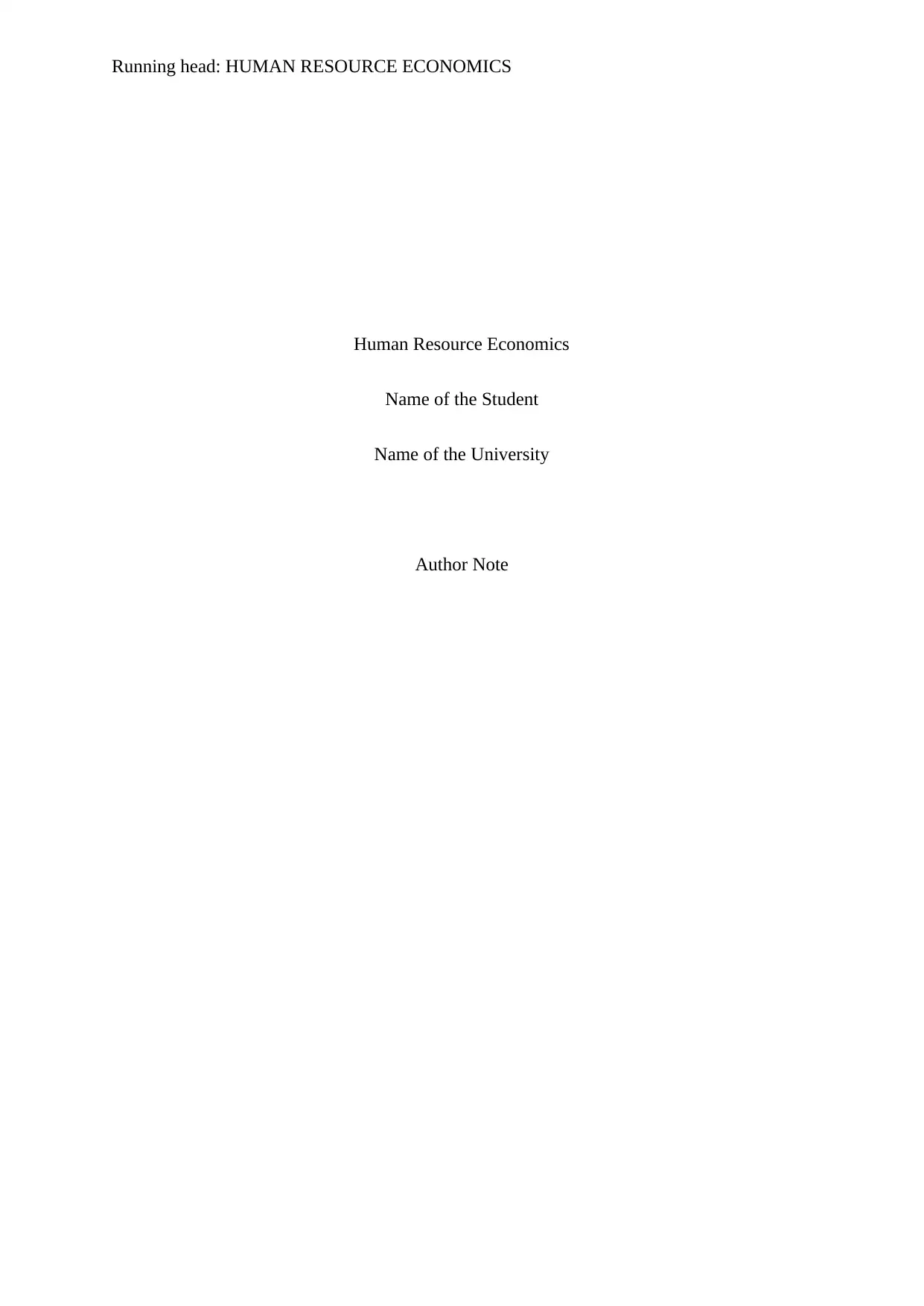
Running head: HUMAN RESOURCE ECONOMICS
Human Resource Economics
Name of the Student
Name of the University
Author Note
Human Resource Economics
Name of the Student
Name of the University
Author Note
Secure Best Marks with AI Grader
Need help grading? Try our AI Grader for instant feedback on your assignments.
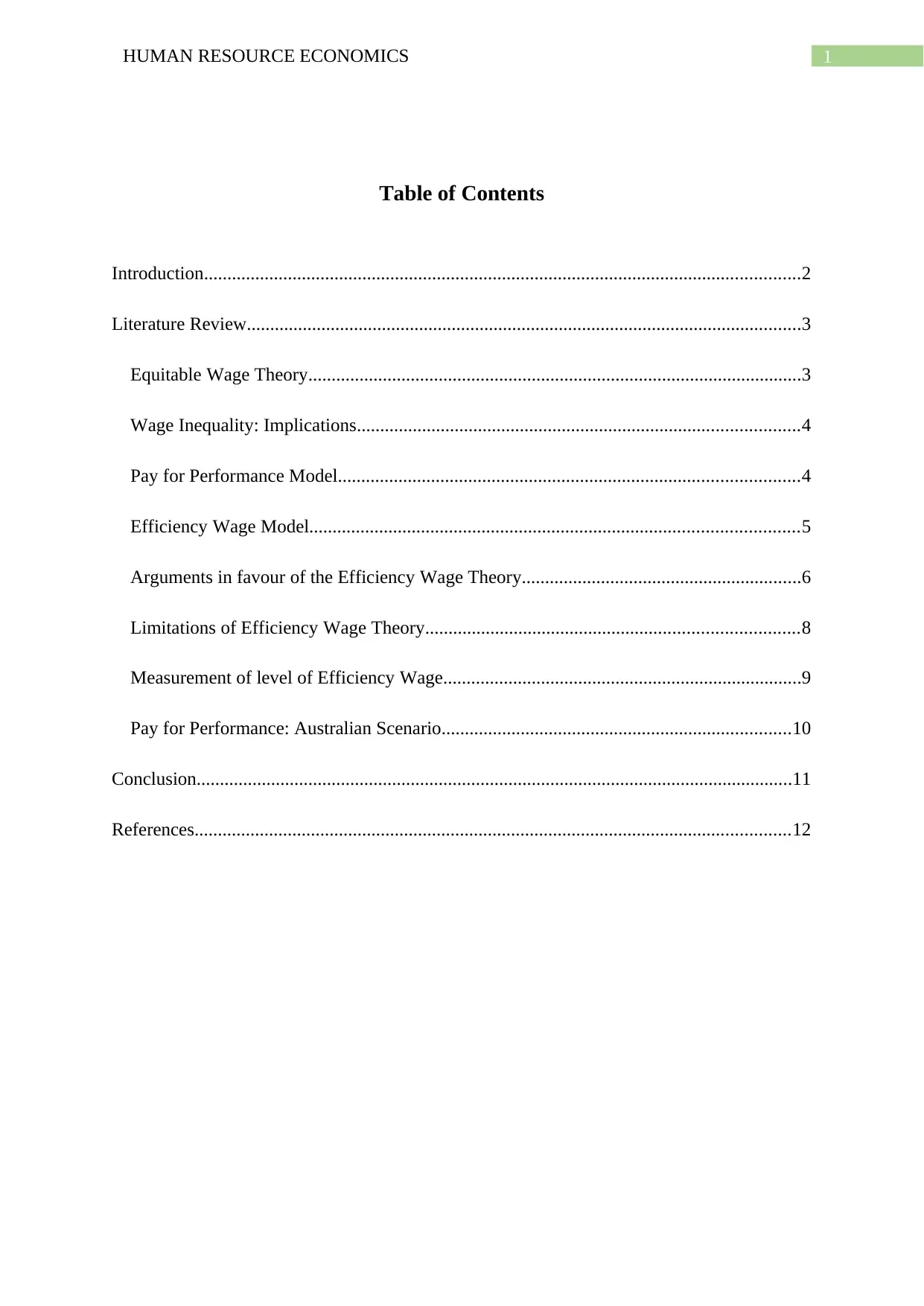
1HUMAN RESOURCE ECONOMICS
Table of Contents
Introduction................................................................................................................................2
Literature Review.......................................................................................................................3
Equitable Wage Theory..........................................................................................................3
Wage Inequality: Implications...............................................................................................4
Pay for Performance Model...................................................................................................4
Efficiency Wage Model.........................................................................................................5
Arguments in favour of the Efficiency Wage Theory............................................................6
Limitations of Efficiency Wage Theory................................................................................8
Measurement of level of Efficiency Wage.............................................................................9
Pay for Performance: Australian Scenario...........................................................................10
Conclusion................................................................................................................................11
References................................................................................................................................12
Table of Contents
Introduction................................................................................................................................2
Literature Review.......................................................................................................................3
Equitable Wage Theory..........................................................................................................3
Wage Inequality: Implications...............................................................................................4
Pay for Performance Model...................................................................................................4
Efficiency Wage Model.........................................................................................................5
Arguments in favour of the Efficiency Wage Theory............................................................6
Limitations of Efficiency Wage Theory................................................................................8
Measurement of level of Efficiency Wage.............................................................................9
Pay for Performance: Australian Scenario...........................................................................10
Conclusion................................................................................................................................11
References................................................................................................................................12
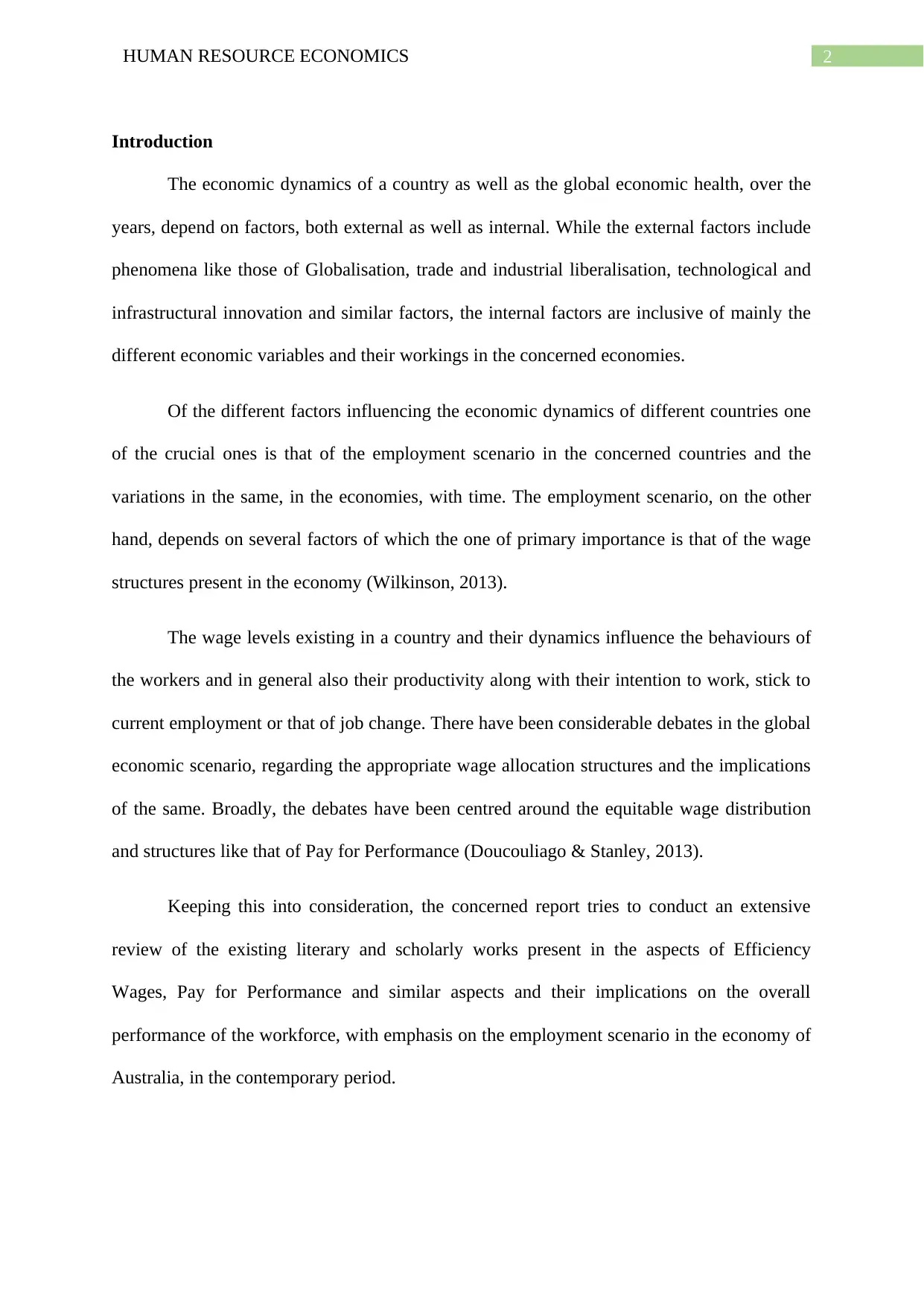
2HUMAN RESOURCE ECONOMICS
Introduction
The economic dynamics of a country as well as the global economic health, over the
years, depend on factors, both external as well as internal. While the external factors include
phenomena like those of Globalisation, trade and industrial liberalisation, technological and
infrastructural innovation and similar factors, the internal factors are inclusive of mainly the
different economic variables and their workings in the concerned economies.
Of the different factors influencing the economic dynamics of different countries one
of the crucial ones is that of the employment scenario in the concerned countries and the
variations in the same, in the economies, with time. The employment scenario, on the other
hand, depends on several factors of which the one of primary importance is that of the wage
structures present in the economy (Wilkinson, 2013).
The wage levels existing in a country and their dynamics influence the behaviours of
the workers and in general also their productivity along with their intention to work, stick to
current employment or that of job change. There have been considerable debates in the global
economic scenario, regarding the appropriate wage allocation structures and the implications
of the same. Broadly, the debates have been centred around the equitable wage distribution
and structures like that of Pay for Performance (Doucouliago & Stanley, 2013).
Keeping this into consideration, the concerned report tries to conduct an extensive
review of the existing literary and scholarly works present in the aspects of Efficiency
Wages, Pay for Performance and similar aspects and their implications on the overall
performance of the workforce, with emphasis on the employment scenario in the economy of
Australia, in the contemporary period.
Introduction
The economic dynamics of a country as well as the global economic health, over the
years, depend on factors, both external as well as internal. While the external factors include
phenomena like those of Globalisation, trade and industrial liberalisation, technological and
infrastructural innovation and similar factors, the internal factors are inclusive of mainly the
different economic variables and their workings in the concerned economies.
Of the different factors influencing the economic dynamics of different countries one
of the crucial ones is that of the employment scenario in the concerned countries and the
variations in the same, in the economies, with time. The employment scenario, on the other
hand, depends on several factors of which the one of primary importance is that of the wage
structures present in the economy (Wilkinson, 2013).
The wage levels existing in a country and their dynamics influence the behaviours of
the workers and in general also their productivity along with their intention to work, stick to
current employment or that of job change. There have been considerable debates in the global
economic scenario, regarding the appropriate wage allocation structures and the implications
of the same. Broadly, the debates have been centred around the equitable wage distribution
and structures like that of Pay for Performance (Doucouliago & Stanley, 2013).
Keeping this into consideration, the concerned report tries to conduct an extensive
review of the existing literary and scholarly works present in the aspects of Efficiency
Wages, Pay for Performance and similar aspects and their implications on the overall
performance of the workforce, with emphasis on the employment scenario in the economy of
Australia, in the contemporary period.
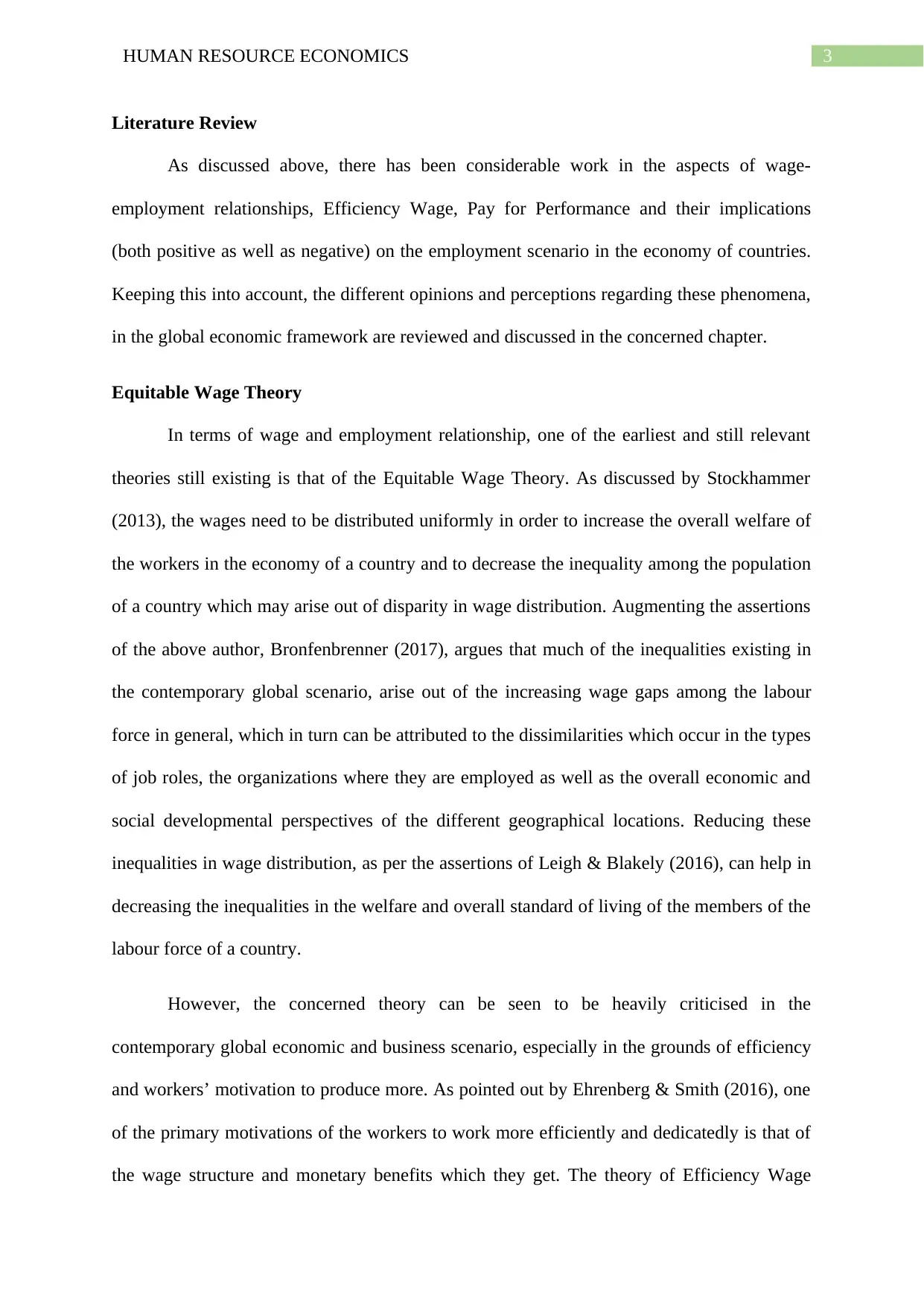
3HUMAN RESOURCE ECONOMICS
Literature Review
As discussed above, there has been considerable work in the aspects of wage-
employment relationships, Efficiency Wage, Pay for Performance and their implications
(both positive as well as negative) on the employment scenario in the economy of countries.
Keeping this into account, the different opinions and perceptions regarding these phenomena,
in the global economic framework are reviewed and discussed in the concerned chapter.
Equitable Wage Theory
In terms of wage and employment relationship, one of the earliest and still relevant
theories still existing is that of the Equitable Wage Theory. As discussed by Stockhammer
(2013), the wages need to be distributed uniformly in order to increase the overall welfare of
the workers in the economy of a country and to decrease the inequality among the population
of a country which may arise out of disparity in wage distribution. Augmenting the assertions
of the above author, Bronfenbrenner (2017), argues that much of the inequalities existing in
the contemporary global scenario, arise out of the increasing wage gaps among the labour
force in general, which in turn can be attributed to the dissimilarities which occur in the types
of job roles, the organizations where they are employed as well as the overall economic and
social developmental perspectives of the different geographical locations. Reducing these
inequalities in wage distribution, as per the assertions of Leigh & Blakely (2016), can help in
decreasing the inequalities in the welfare and overall standard of living of the members of the
labour force of a country.
However, the concerned theory can be seen to be heavily criticised in the
contemporary global economic and business scenario, especially in the grounds of efficiency
and workers’ motivation to produce more. As pointed out by Ehrenberg & Smith (2016), one
of the primary motivations of the workers to work more efficiently and dedicatedly is that of
the wage structure and monetary benefits which they get. The theory of Efficiency Wage
Literature Review
As discussed above, there has been considerable work in the aspects of wage-
employment relationships, Efficiency Wage, Pay for Performance and their implications
(both positive as well as negative) on the employment scenario in the economy of countries.
Keeping this into account, the different opinions and perceptions regarding these phenomena,
in the global economic framework are reviewed and discussed in the concerned chapter.
Equitable Wage Theory
In terms of wage and employment relationship, one of the earliest and still relevant
theories still existing is that of the Equitable Wage Theory. As discussed by Stockhammer
(2013), the wages need to be distributed uniformly in order to increase the overall welfare of
the workers in the economy of a country and to decrease the inequality among the population
of a country which may arise out of disparity in wage distribution. Augmenting the assertions
of the above author, Bronfenbrenner (2017), argues that much of the inequalities existing in
the contemporary global scenario, arise out of the increasing wage gaps among the labour
force in general, which in turn can be attributed to the dissimilarities which occur in the types
of job roles, the organizations where they are employed as well as the overall economic and
social developmental perspectives of the different geographical locations. Reducing these
inequalities in wage distribution, as per the assertions of Leigh & Blakely (2016), can help in
decreasing the inequalities in the welfare and overall standard of living of the members of the
labour force of a country.
However, the concerned theory can be seen to be heavily criticised in the
contemporary global economic and business scenario, especially in the grounds of efficiency
and workers’ motivation to produce more. As pointed out by Ehrenberg & Smith (2016), one
of the primary motivations of the workers to work more efficiently and dedicatedly is that of
the wage structure and monetary benefits which they get. The theory of Efficiency Wage
Secure Best Marks with AI Grader
Need help grading? Try our AI Grader for instant feedback on your assignments.
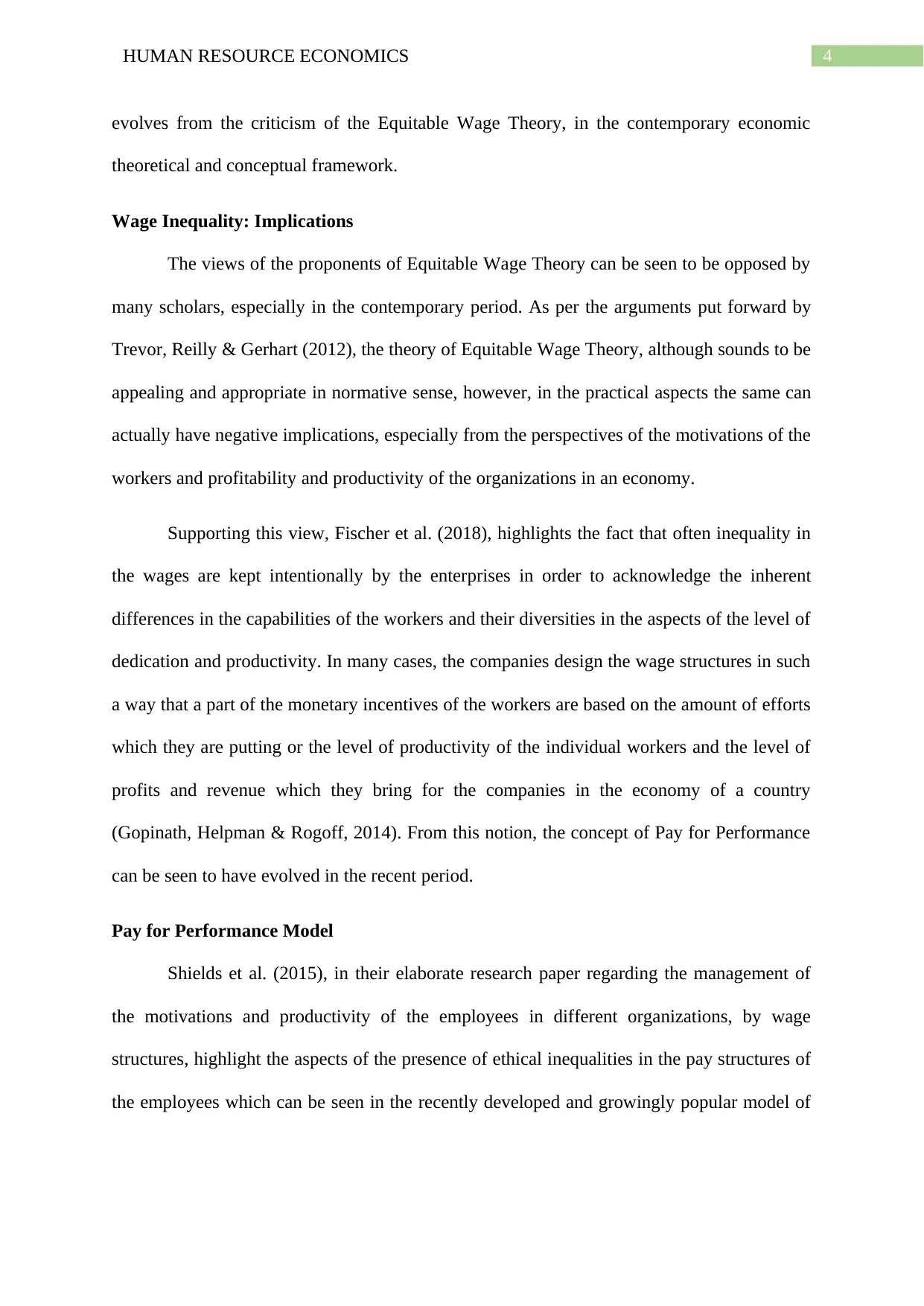
4HUMAN RESOURCE ECONOMICS
evolves from the criticism of the Equitable Wage Theory, in the contemporary economic
theoretical and conceptual framework.
Wage Inequality: Implications
The views of the proponents of Equitable Wage Theory can be seen to be opposed by
many scholars, especially in the contemporary period. As per the arguments put forward by
Trevor, Reilly & Gerhart (2012), the theory of Equitable Wage Theory, although sounds to be
appealing and appropriate in normative sense, however, in the practical aspects the same can
actually have negative implications, especially from the perspectives of the motivations of the
workers and profitability and productivity of the organizations in an economy.
Supporting this view, Fischer et al. (2018), highlights the fact that often inequality in
the wages are kept intentionally by the enterprises in order to acknowledge the inherent
differences in the capabilities of the workers and their diversities in the aspects of the level of
dedication and productivity. In many cases, the companies design the wage structures in such
a way that a part of the monetary incentives of the workers are based on the amount of efforts
which they are putting or the level of productivity of the individual workers and the level of
profits and revenue which they bring for the companies in the economy of a country
(Gopinath, Helpman & Rogoff, 2014). From this notion, the concept of Pay for Performance
can be seen to have evolved in the recent period.
Pay for Performance Model
Shields et al. (2015), in their elaborate research paper regarding the management of
the motivations and productivity of the employees in different organizations, by wage
structures, highlight the aspects of the presence of ethical inequalities in the pay structures of
the employees which can be seen in the recently developed and growingly popular model of
evolves from the criticism of the Equitable Wage Theory, in the contemporary economic
theoretical and conceptual framework.
Wage Inequality: Implications
The views of the proponents of Equitable Wage Theory can be seen to be opposed by
many scholars, especially in the contemporary period. As per the arguments put forward by
Trevor, Reilly & Gerhart (2012), the theory of Equitable Wage Theory, although sounds to be
appealing and appropriate in normative sense, however, in the practical aspects the same can
actually have negative implications, especially from the perspectives of the motivations of the
workers and profitability and productivity of the organizations in an economy.
Supporting this view, Fischer et al. (2018), highlights the fact that often inequality in
the wages are kept intentionally by the enterprises in order to acknowledge the inherent
differences in the capabilities of the workers and their diversities in the aspects of the level of
dedication and productivity. In many cases, the companies design the wage structures in such
a way that a part of the monetary incentives of the workers are based on the amount of efforts
which they are putting or the level of productivity of the individual workers and the level of
profits and revenue which they bring for the companies in the economy of a country
(Gopinath, Helpman & Rogoff, 2014). From this notion, the concept of Pay for Performance
can be seen to have evolved in the recent period.
Pay for Performance Model
Shields et al. (2015), in their elaborate research paper regarding the management of
the motivations and productivity of the employees in different organizations, by wage
structures, highlight the aspects of the presence of ethical inequalities in the pay structures of
the employees which can be seen in the recently developed and growingly popular model of
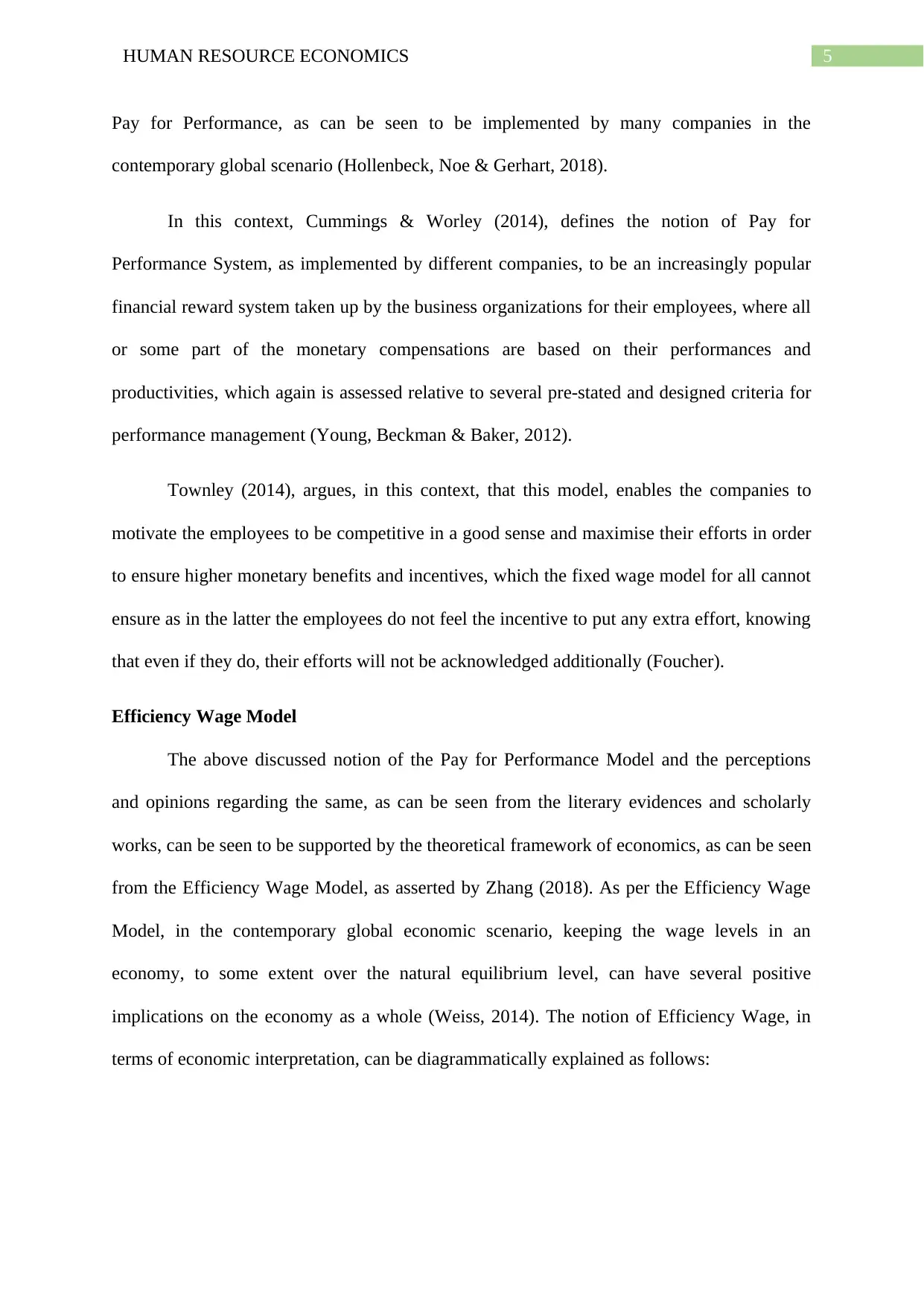
5HUMAN RESOURCE ECONOMICS
Pay for Performance, as can be seen to be implemented by many companies in the
contemporary global scenario (Hollenbeck, Noe & Gerhart, 2018).
In this context, Cummings & Worley (2014), defines the notion of Pay for
Performance System, as implemented by different companies, to be an increasingly popular
financial reward system taken up by the business organizations for their employees, where all
or some part of the monetary compensations are based on their performances and
productivities, which again is assessed relative to several pre-stated and designed criteria for
performance management (Young, Beckman & Baker, 2012).
Townley (2014), argues, in this context, that this model, enables the companies to
motivate the employees to be competitive in a good sense and maximise their efforts in order
to ensure higher monetary benefits and incentives, which the fixed wage model for all cannot
ensure as in the latter the employees do not feel the incentive to put any extra effort, knowing
that even if they do, their efforts will not be acknowledged additionally (Foucher).
Efficiency Wage Model
The above discussed notion of the Pay for Performance Model and the perceptions
and opinions regarding the same, as can be seen from the literary evidences and scholarly
works, can be seen to be supported by the theoretical framework of economics, as can be seen
from the Efficiency Wage Model, as asserted by Zhang (2018). As per the Efficiency Wage
Model, in the contemporary global economic scenario, keeping the wage levels in an
economy, to some extent over the natural equilibrium level, can have several positive
implications on the economy as a whole (Weiss, 2014). The notion of Efficiency Wage, in
terms of economic interpretation, can be diagrammatically explained as follows:
Pay for Performance, as can be seen to be implemented by many companies in the
contemporary global scenario (Hollenbeck, Noe & Gerhart, 2018).
In this context, Cummings & Worley (2014), defines the notion of Pay for
Performance System, as implemented by different companies, to be an increasingly popular
financial reward system taken up by the business organizations for their employees, where all
or some part of the monetary compensations are based on their performances and
productivities, which again is assessed relative to several pre-stated and designed criteria for
performance management (Young, Beckman & Baker, 2012).
Townley (2014), argues, in this context, that this model, enables the companies to
motivate the employees to be competitive in a good sense and maximise their efforts in order
to ensure higher monetary benefits and incentives, which the fixed wage model for all cannot
ensure as in the latter the employees do not feel the incentive to put any extra effort, knowing
that even if they do, their efforts will not be acknowledged additionally (Foucher).
Efficiency Wage Model
The above discussed notion of the Pay for Performance Model and the perceptions
and opinions regarding the same, as can be seen from the literary evidences and scholarly
works, can be seen to be supported by the theoretical framework of economics, as can be seen
from the Efficiency Wage Model, as asserted by Zhang (2018). As per the Efficiency Wage
Model, in the contemporary global economic scenario, keeping the wage levels in an
economy, to some extent over the natural equilibrium level, can have several positive
implications on the economy as a whole (Weiss, 2014). The notion of Efficiency Wage, in
terms of economic interpretation, can be diagrammatically explained as follows:
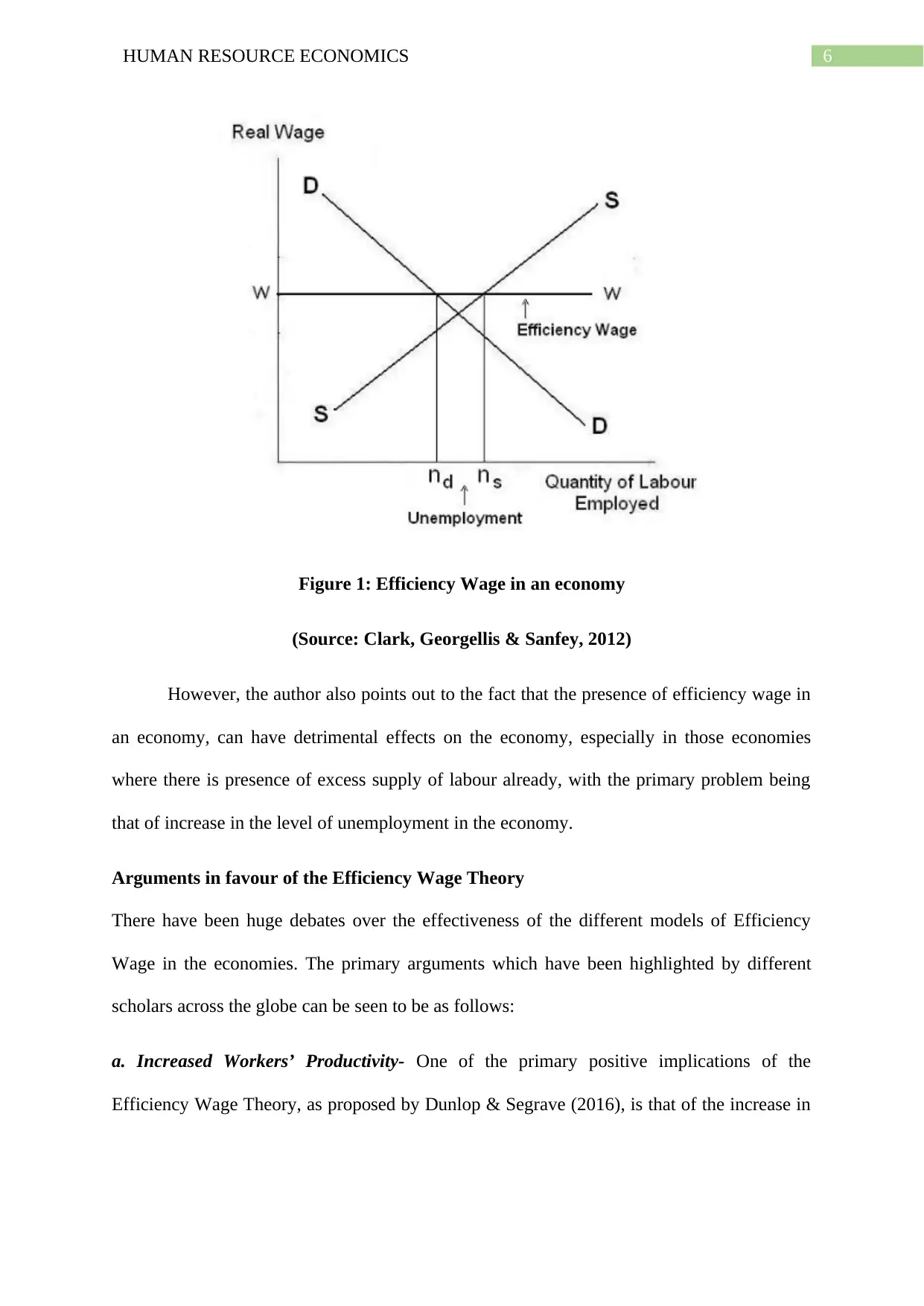
6HUMAN RESOURCE ECONOMICS
Figure 1: Efficiency Wage in an economy
(Source: Clark, Georgellis & Sanfey, 2012)
However, the author also points out to the fact that the presence of efficiency wage in
an economy, can have detrimental effects on the economy, especially in those economies
where there is presence of excess supply of labour already, with the primary problem being
that of increase in the level of unemployment in the economy.
Arguments in favour of the Efficiency Wage Theory
There have been huge debates over the effectiveness of the different models of Efficiency
Wage in the economies. The primary arguments which have been highlighted by different
scholars across the globe can be seen to be as follows:
a. Increased Workers’ Productivity- One of the primary positive implications of the
Efficiency Wage Theory, as proposed by Dunlop & Segrave (2016), is that of the increase in
Figure 1: Efficiency Wage in an economy
(Source: Clark, Georgellis & Sanfey, 2012)
However, the author also points out to the fact that the presence of efficiency wage in
an economy, can have detrimental effects on the economy, especially in those economies
where there is presence of excess supply of labour already, with the primary problem being
that of increase in the level of unemployment in the economy.
Arguments in favour of the Efficiency Wage Theory
There have been huge debates over the effectiveness of the different models of Efficiency
Wage in the economies. The primary arguments which have been highlighted by different
scholars across the globe can be seen to be as follows:
a. Increased Workers’ Productivity- One of the primary positive implications of the
Efficiency Wage Theory, as proposed by Dunlop & Segrave (2016), is that of the increase in
Paraphrase This Document
Need a fresh take? Get an instant paraphrase of this document with our AI Paraphraser
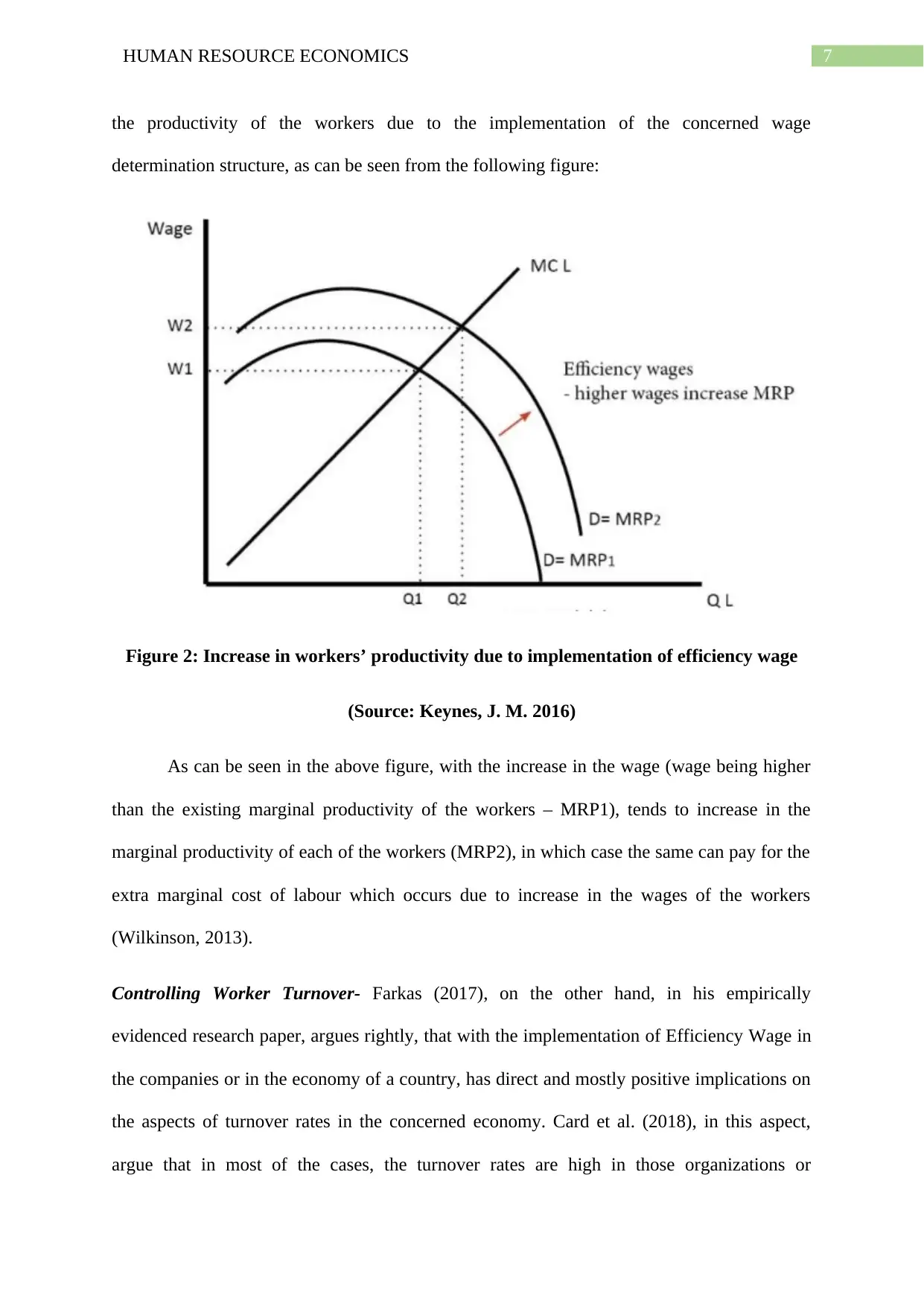
7HUMAN RESOURCE ECONOMICS
the productivity of the workers due to the implementation of the concerned wage
determination structure, as can be seen from the following figure:
Figure 2: Increase in workers’ productivity due to implementation of efficiency wage
(Source: Keynes, J. M. 2016)
As can be seen in the above figure, with the increase in the wage (wage being higher
than the existing marginal productivity of the workers – MRP1), tends to increase in the
marginal productivity of each of the workers (MRP2), in which case the same can pay for the
extra marginal cost of labour which occurs due to increase in the wages of the workers
(Wilkinson, 2013).
Controlling Worker Turnover- Farkas (2017), on the other hand, in his empirically
evidenced research paper, argues rightly, that with the implementation of Efficiency Wage in
the companies or in the economy of a country, has direct and mostly positive implications on
the aspects of turnover rates in the concerned economy. Card et al. (2018), in this aspect,
argue that in most of the cases, the turnover rates are high in those organizations or
the productivity of the workers due to the implementation of the concerned wage
determination structure, as can be seen from the following figure:
Figure 2: Increase in workers’ productivity due to implementation of efficiency wage
(Source: Keynes, J. M. 2016)
As can be seen in the above figure, with the increase in the wage (wage being higher
than the existing marginal productivity of the workers – MRP1), tends to increase in the
marginal productivity of each of the workers (MRP2), in which case the same can pay for the
extra marginal cost of labour which occurs due to increase in the wages of the workers
(Wilkinson, 2013).
Controlling Worker Turnover- Farkas (2017), on the other hand, in his empirically
evidenced research paper, argues rightly, that with the implementation of Efficiency Wage in
the companies or in the economy of a country, has direct and mostly positive implications on
the aspects of turnover rates in the concerned economy. Card et al. (2018), in this aspect,
argue that in most of the cases, the turnover rates are high in those organizations or
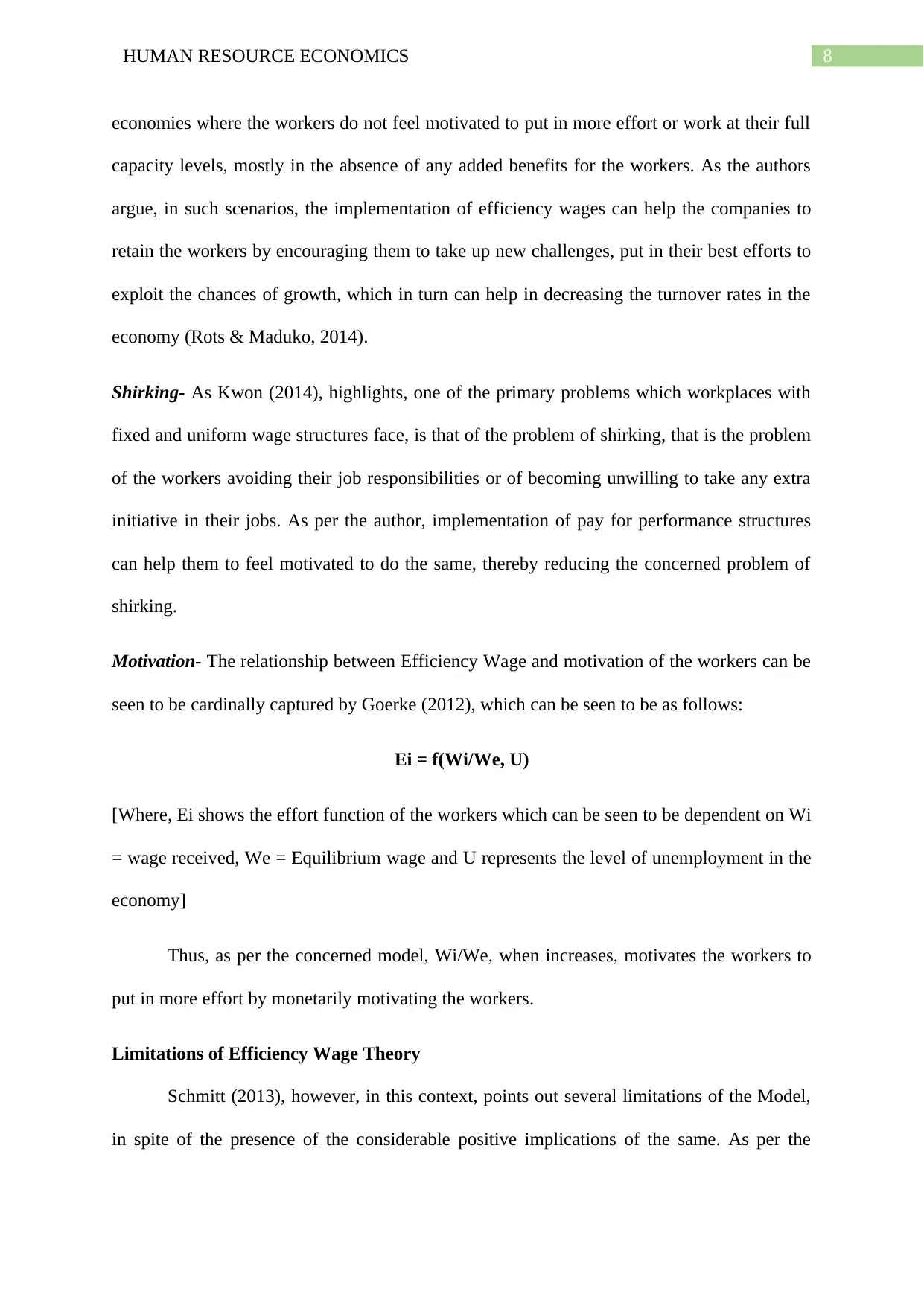
8HUMAN RESOURCE ECONOMICS
economies where the workers do not feel motivated to put in more effort or work at their full
capacity levels, mostly in the absence of any added benefits for the workers. As the authors
argue, in such scenarios, the implementation of efficiency wages can help the companies to
retain the workers by encouraging them to take up new challenges, put in their best efforts to
exploit the chances of growth, which in turn can help in decreasing the turnover rates in the
economy (Rots & Maduko, 2014).
Shirking- As Kwon (2014), highlights, one of the primary problems which workplaces with
fixed and uniform wage structures face, is that of the problem of shirking, that is the problem
of the workers avoiding their job responsibilities or of becoming unwilling to take any extra
initiative in their jobs. As per the author, implementation of pay for performance structures
can help them to feel motivated to do the same, thereby reducing the concerned problem of
shirking.
Motivation- The relationship between Efficiency Wage and motivation of the workers can be
seen to be cardinally captured by Goerke (2012), which can be seen to be as follows:
Ei = f(Wi/We, U)
[Where, Ei shows the effort function of the workers which can be seen to be dependent on Wi
= wage received, We = Equilibrium wage and U represents the level of unemployment in the
economy]
Thus, as per the concerned model, Wi/We, when increases, motivates the workers to
put in more effort by monetarily motivating the workers.
Limitations of Efficiency Wage Theory
Schmitt (2013), however, in this context, points out several limitations of the Model,
in spite of the presence of the considerable positive implications of the same. As per the
economies where the workers do not feel motivated to put in more effort or work at their full
capacity levels, mostly in the absence of any added benefits for the workers. As the authors
argue, in such scenarios, the implementation of efficiency wages can help the companies to
retain the workers by encouraging them to take up new challenges, put in their best efforts to
exploit the chances of growth, which in turn can help in decreasing the turnover rates in the
economy (Rots & Maduko, 2014).
Shirking- As Kwon (2014), highlights, one of the primary problems which workplaces with
fixed and uniform wage structures face, is that of the problem of shirking, that is the problem
of the workers avoiding their job responsibilities or of becoming unwilling to take any extra
initiative in their jobs. As per the author, implementation of pay for performance structures
can help them to feel motivated to do the same, thereby reducing the concerned problem of
shirking.
Motivation- The relationship between Efficiency Wage and motivation of the workers can be
seen to be cardinally captured by Goerke (2012), which can be seen to be as follows:
Ei = f(Wi/We, U)
[Where, Ei shows the effort function of the workers which can be seen to be dependent on Wi
= wage received, We = Equilibrium wage and U represents the level of unemployment in the
economy]
Thus, as per the concerned model, Wi/We, when increases, motivates the workers to
put in more effort by monetarily motivating the workers.
Limitations of Efficiency Wage Theory
Schmitt (2013), however, in this context, points out several limitations of the Model,
in spite of the presence of the considerable positive implications of the same. As per the
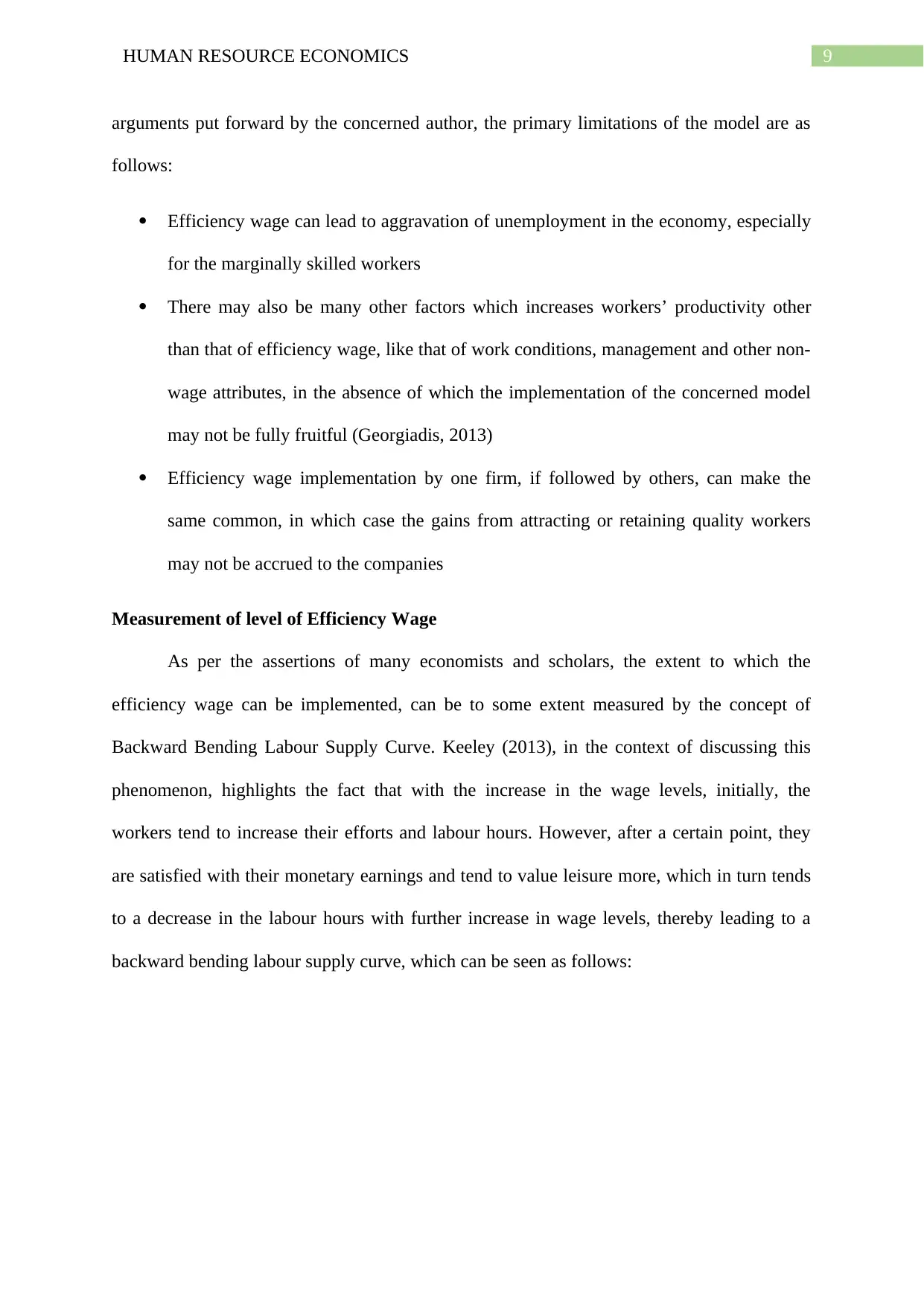
9HUMAN RESOURCE ECONOMICS
arguments put forward by the concerned author, the primary limitations of the model are as
follows:
Efficiency wage can lead to aggravation of unemployment in the economy, especially
for the marginally skilled workers
There may also be many other factors which increases workers’ productivity other
than that of efficiency wage, like that of work conditions, management and other non-
wage attributes, in the absence of which the implementation of the concerned model
may not be fully fruitful (Georgiadis, 2013)
Efficiency wage implementation by one firm, if followed by others, can make the
same common, in which case the gains from attracting or retaining quality workers
may not be accrued to the companies
Measurement of level of Efficiency Wage
As per the assertions of many economists and scholars, the extent to which the
efficiency wage can be implemented, can be to some extent measured by the concept of
Backward Bending Labour Supply Curve. Keeley (2013), in the context of discussing this
phenomenon, highlights the fact that with the increase in the wage levels, initially, the
workers tend to increase their efforts and labour hours. However, after a certain point, they
are satisfied with their monetary earnings and tend to value leisure more, which in turn tends
to a decrease in the labour hours with further increase in wage levels, thereby leading to a
backward bending labour supply curve, which can be seen as follows:
arguments put forward by the concerned author, the primary limitations of the model are as
follows:
Efficiency wage can lead to aggravation of unemployment in the economy, especially
for the marginally skilled workers
There may also be many other factors which increases workers’ productivity other
than that of efficiency wage, like that of work conditions, management and other non-
wage attributes, in the absence of which the implementation of the concerned model
may not be fully fruitful (Georgiadis, 2013)
Efficiency wage implementation by one firm, if followed by others, can make the
same common, in which case the gains from attracting or retaining quality workers
may not be accrued to the companies
Measurement of level of Efficiency Wage
As per the assertions of many economists and scholars, the extent to which the
efficiency wage can be implemented, can be to some extent measured by the concept of
Backward Bending Labour Supply Curve. Keeley (2013), in the context of discussing this
phenomenon, highlights the fact that with the increase in the wage levels, initially, the
workers tend to increase their efforts and labour hours. However, after a certain point, they
are satisfied with their monetary earnings and tend to value leisure more, which in turn tends
to a decrease in the labour hours with further increase in wage levels, thereby leading to a
backward bending labour supply curve, which can be seen as follows:
Secure Best Marks with AI Grader
Need help grading? Try our AI Grader for instant feedback on your assignments.
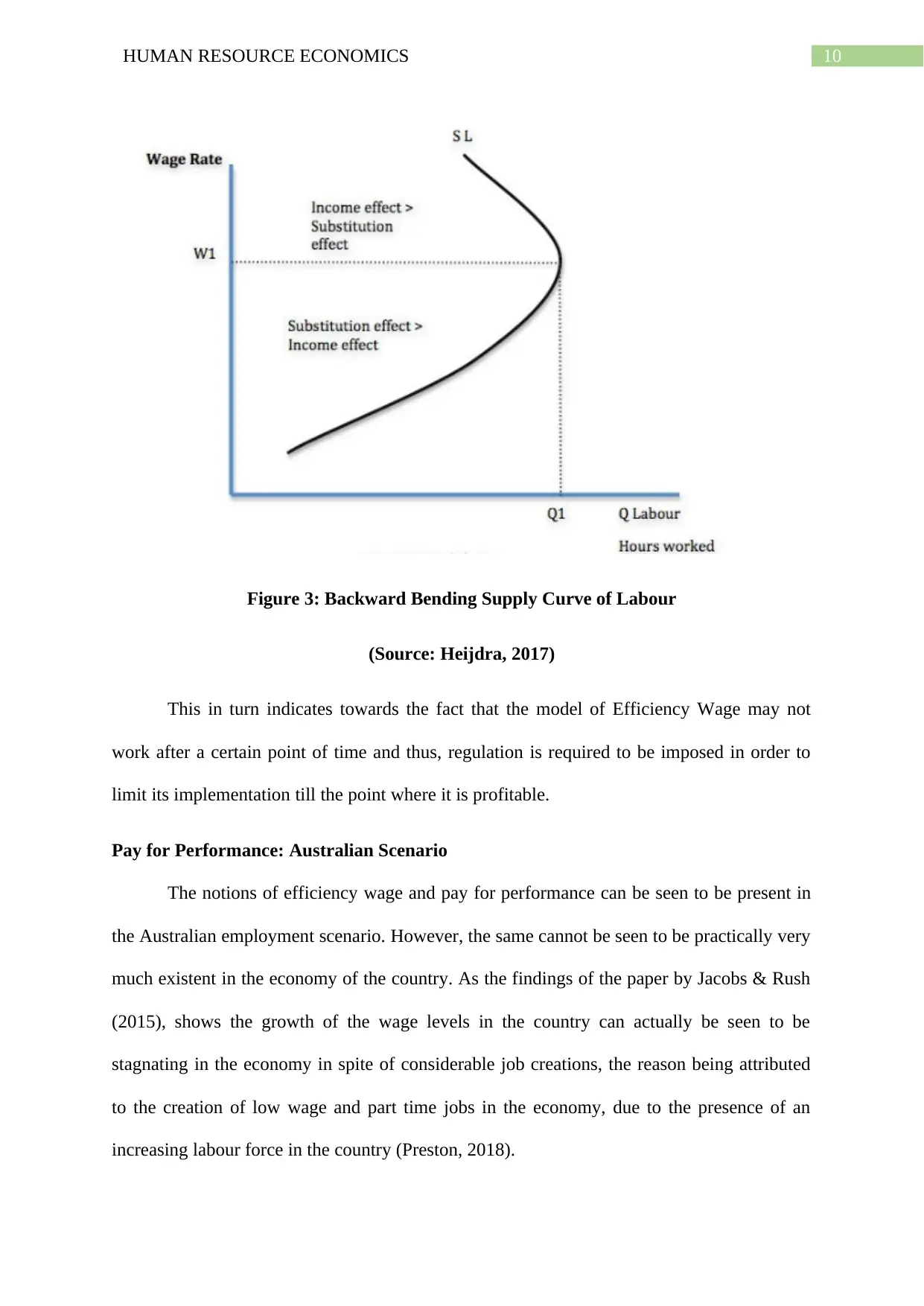
10HUMAN RESOURCE ECONOMICS
Figure 3: Backward Bending Supply Curve of Labour
(Source: Heijdra, 2017)
This in turn indicates towards the fact that the model of Efficiency Wage may not
work after a certain point of time and thus, regulation is required to be imposed in order to
limit its implementation till the point where it is profitable.
Pay for Performance: Australian Scenario
The notions of efficiency wage and pay for performance can be seen to be present in
the Australian employment scenario. However, the same cannot be seen to be practically very
much existent in the economy of the country. As the findings of the paper by Jacobs & Rush
(2015), shows the growth of the wage levels in the country can actually be seen to be
stagnating in the economy in spite of considerable job creations, the reason being attributed
to the creation of low wage and part time jobs in the economy, due to the presence of an
increasing labour force in the country (Preston, 2018).
Figure 3: Backward Bending Supply Curve of Labour
(Source: Heijdra, 2017)
This in turn indicates towards the fact that the model of Efficiency Wage may not
work after a certain point of time and thus, regulation is required to be imposed in order to
limit its implementation till the point where it is profitable.
Pay for Performance: Australian Scenario
The notions of efficiency wage and pay for performance can be seen to be present in
the Australian employment scenario. However, the same cannot be seen to be practically very
much existent in the economy of the country. As the findings of the paper by Jacobs & Rush
(2015), shows the growth of the wage levels in the country can actually be seen to be
stagnating in the economy in spite of considerable job creations, the reason being attributed
to the creation of low wage and part time jobs in the economy, due to the presence of an
increasing labour force in the country (Preston, 2018).
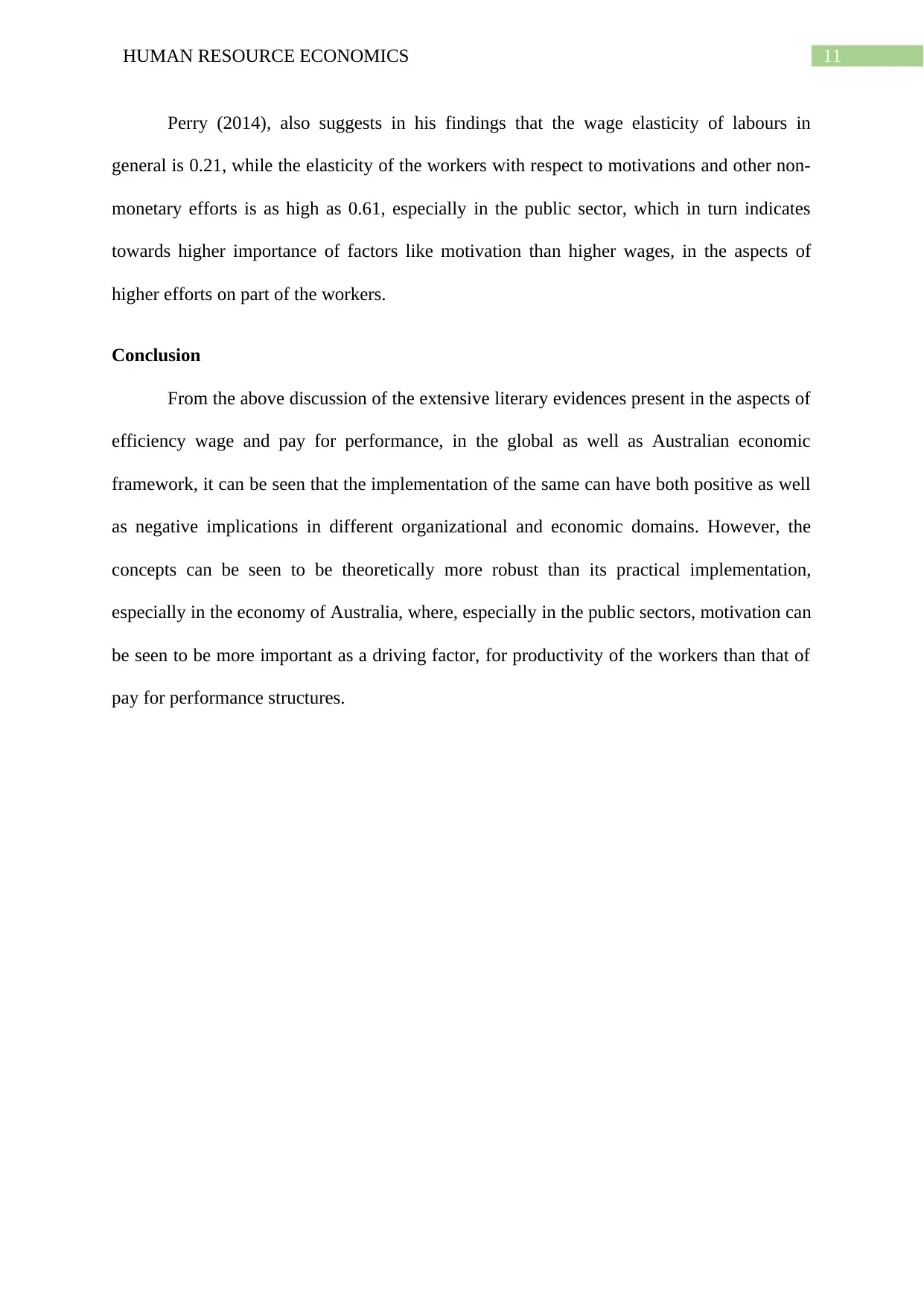
11HUMAN RESOURCE ECONOMICS
Perry (2014), also suggests in his findings that the wage elasticity of labours in
general is 0.21, while the elasticity of the workers with respect to motivations and other non-
monetary efforts is as high as 0.61, especially in the public sector, which in turn indicates
towards higher importance of factors like motivation than higher wages, in the aspects of
higher efforts on part of the workers.
Conclusion
From the above discussion of the extensive literary evidences present in the aspects of
efficiency wage and pay for performance, in the global as well as Australian economic
framework, it can be seen that the implementation of the same can have both positive as well
as negative implications in different organizational and economic domains. However, the
concepts can be seen to be theoretically more robust than its practical implementation,
especially in the economy of Australia, where, especially in the public sectors, motivation can
be seen to be more important as a driving factor, for productivity of the workers than that of
pay for performance structures.
Perry (2014), also suggests in his findings that the wage elasticity of labours in
general is 0.21, while the elasticity of the workers with respect to motivations and other non-
monetary efforts is as high as 0.61, especially in the public sector, which in turn indicates
towards higher importance of factors like motivation than higher wages, in the aspects of
higher efforts on part of the workers.
Conclusion
From the above discussion of the extensive literary evidences present in the aspects of
efficiency wage and pay for performance, in the global as well as Australian economic
framework, it can be seen that the implementation of the same can have both positive as well
as negative implications in different organizational and economic domains. However, the
concepts can be seen to be theoretically more robust than its practical implementation,
especially in the economy of Australia, where, especially in the public sectors, motivation can
be seen to be more important as a driving factor, for productivity of the workers than that of
pay for performance structures.
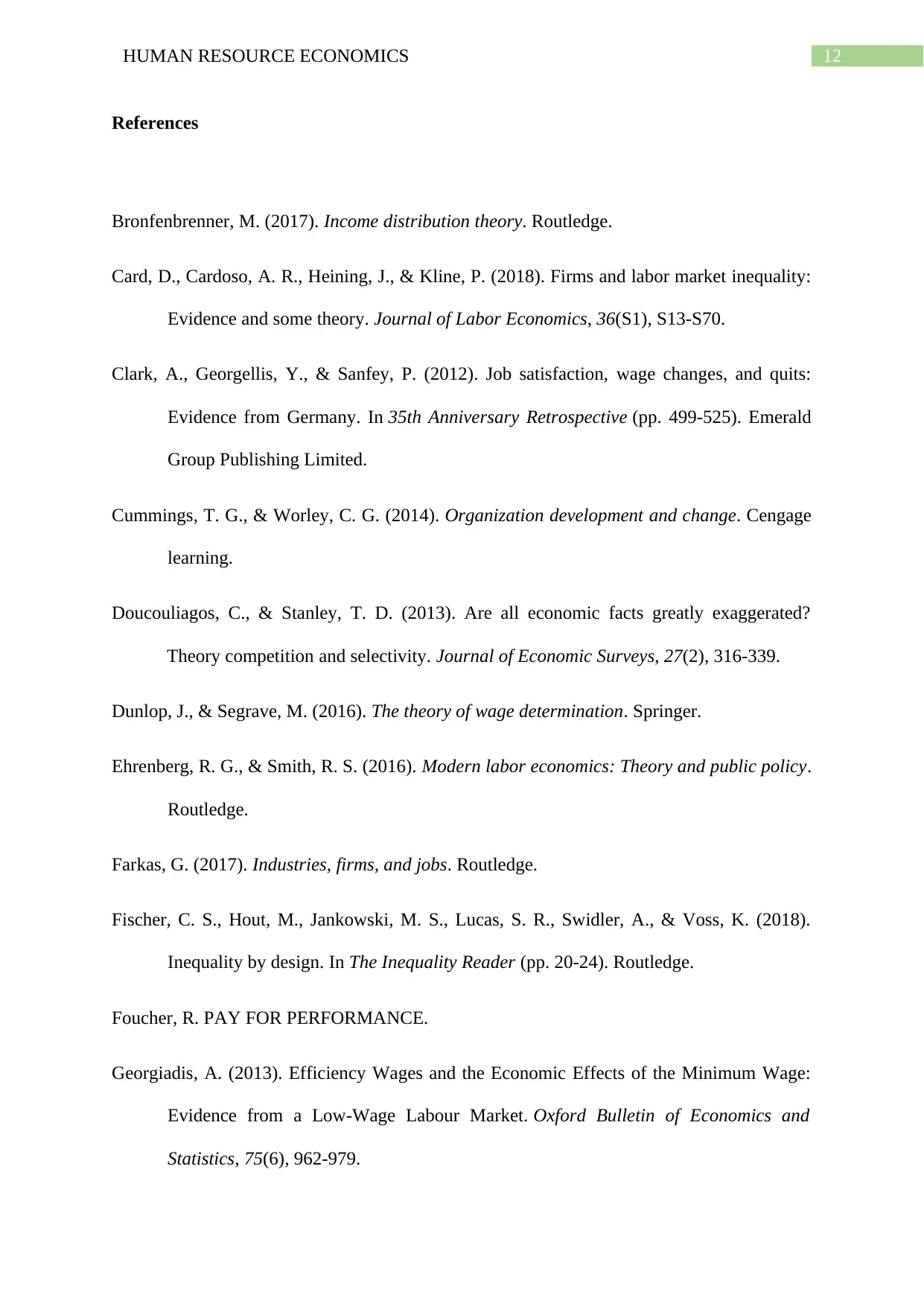
12HUMAN RESOURCE ECONOMICS
References
Bronfenbrenner, M. (2017). Income distribution theory. Routledge.
Card, D., Cardoso, A. R., Heining, J., & Kline, P. (2018). Firms and labor market inequality:
Evidence and some theory. Journal of Labor Economics, 36(S1), S13-S70.
Clark, A., Georgellis, Y., & Sanfey, P. (2012). Job satisfaction, wage changes, and quits:
Evidence from Germany. In 35th Anniversary Retrospective (pp. 499-525). Emerald
Group Publishing Limited.
Cummings, T. G., & Worley, C. G. (2014). Organization development and change. Cengage
learning.
Doucouliagos, C., & Stanley, T. D. (2013). Are all economic facts greatly exaggerated?
Theory competition and selectivity. Journal of Economic Surveys, 27(2), 316-339.
Dunlop, J., & Segrave, M. (2016). The theory of wage determination. Springer.
Ehrenberg, R. G., & Smith, R. S. (2016). Modern labor economics: Theory and public policy.
Routledge.
Farkas, G. (2017). Industries, firms, and jobs. Routledge.
Fischer, C. S., Hout, M., Jankowski, M. S., Lucas, S. R., Swidler, A., & Voss, K. (2018).
Inequality by design. In The Inequality Reader (pp. 20-24). Routledge.
Foucher, R. PAY FOR PERFORMANCE.
Georgiadis, A. (2013). Efficiency Wages and the Economic Effects of the Minimum Wage:
Evidence from a Low‐Wage Labour Market. Oxford Bulletin of Economics and
Statistics, 75(6), 962-979.
References
Bronfenbrenner, M. (2017). Income distribution theory. Routledge.
Card, D., Cardoso, A. R., Heining, J., & Kline, P. (2018). Firms and labor market inequality:
Evidence and some theory. Journal of Labor Economics, 36(S1), S13-S70.
Clark, A., Georgellis, Y., & Sanfey, P. (2012). Job satisfaction, wage changes, and quits:
Evidence from Germany. In 35th Anniversary Retrospective (pp. 499-525). Emerald
Group Publishing Limited.
Cummings, T. G., & Worley, C. G. (2014). Organization development and change. Cengage
learning.
Doucouliagos, C., & Stanley, T. D. (2013). Are all economic facts greatly exaggerated?
Theory competition and selectivity. Journal of Economic Surveys, 27(2), 316-339.
Dunlop, J., & Segrave, M. (2016). The theory of wage determination. Springer.
Ehrenberg, R. G., & Smith, R. S. (2016). Modern labor economics: Theory and public policy.
Routledge.
Farkas, G. (2017). Industries, firms, and jobs. Routledge.
Fischer, C. S., Hout, M., Jankowski, M. S., Lucas, S. R., Swidler, A., & Voss, K. (2018).
Inequality by design. In The Inequality Reader (pp. 20-24). Routledge.
Foucher, R. PAY FOR PERFORMANCE.
Georgiadis, A. (2013). Efficiency Wages and the Economic Effects of the Minimum Wage:
Evidence from a Low‐Wage Labour Market. Oxford Bulletin of Economics and
Statistics, 75(6), 962-979.
Paraphrase This Document
Need a fresh take? Get an instant paraphrase of this document with our AI Paraphraser
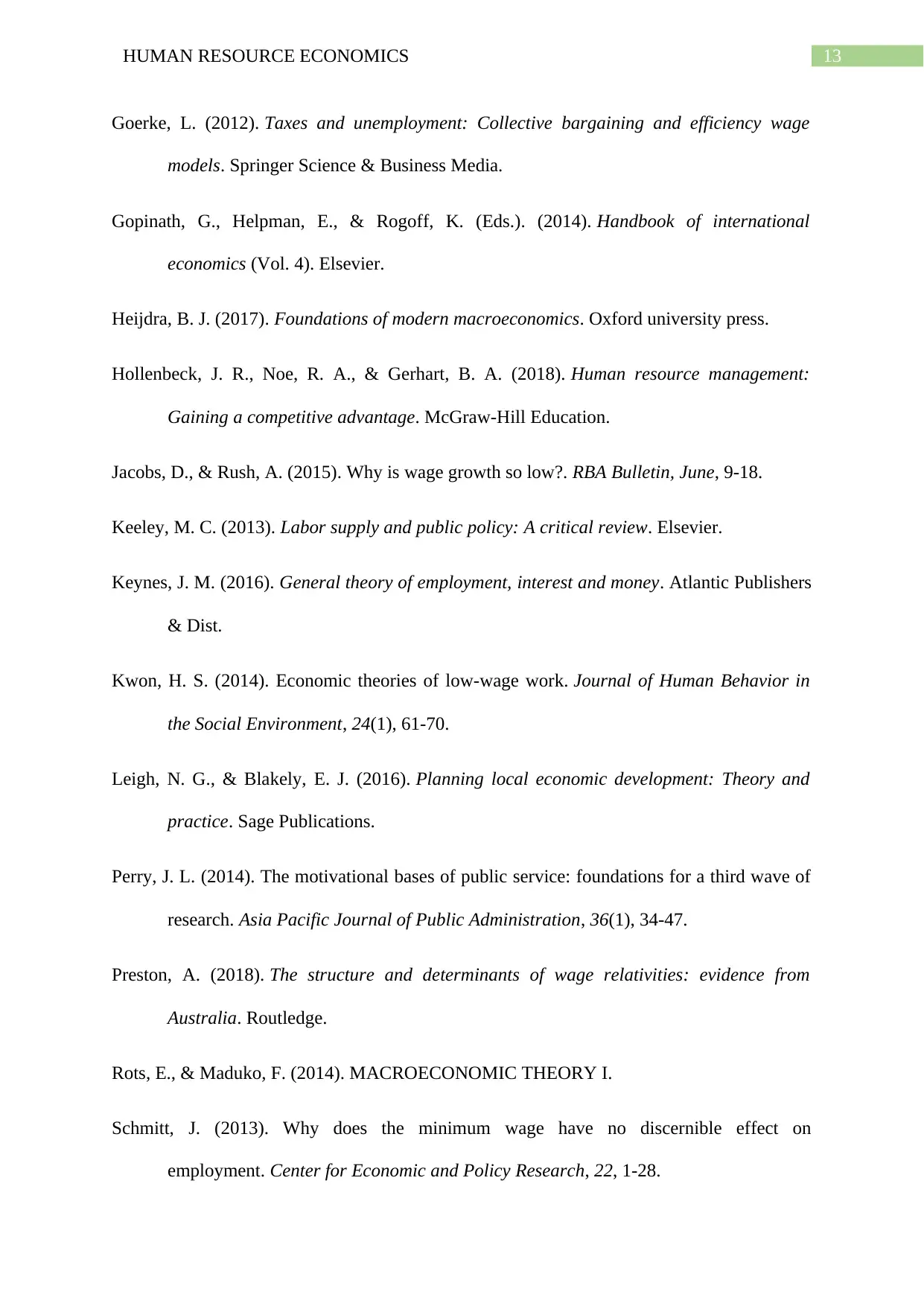
13HUMAN RESOURCE ECONOMICS
Goerke, L. (2012). Taxes and unemployment: Collective bargaining and efficiency wage
models. Springer Science & Business Media.
Gopinath, G., Helpman, E., & Rogoff, K. (Eds.). (2014). Handbook of international
economics (Vol. 4). Elsevier.
Heijdra, B. J. (2017). Foundations of modern macroeconomics. Oxford university press.
Hollenbeck, J. R., Noe, R. A., & Gerhart, B. A. (2018). Human resource management:
Gaining a competitive advantage. McGraw-Hill Education.
Jacobs, D., & Rush, A. (2015). Why is wage growth so low?. RBA Bulletin, June, 9-18.
Keeley, M. C. (2013). Labor supply and public policy: A critical review. Elsevier.
Keynes, J. M. (2016). General theory of employment, interest and money. Atlantic Publishers
& Dist.
Kwon, H. S. (2014). Economic theories of low-wage work. Journal of Human Behavior in
the Social Environment, 24(1), 61-70.
Leigh, N. G., & Blakely, E. J. (2016). Planning local economic development: Theory and
practice. Sage Publications.
Perry, J. L. (2014). The motivational bases of public service: foundations for a third wave of
research. Asia Pacific Journal of Public Administration, 36(1), 34-47.
Preston, A. (2018). The structure and determinants of wage relativities: evidence from
Australia. Routledge.
Rots, E., & Maduko, F. (2014). MACROECONOMIC THEORY I.
Schmitt, J. (2013). Why does the minimum wage have no discernible effect on
employment. Center for Economic and Policy Research, 22, 1-28.
Goerke, L. (2012). Taxes and unemployment: Collective bargaining and efficiency wage
models. Springer Science & Business Media.
Gopinath, G., Helpman, E., & Rogoff, K. (Eds.). (2014). Handbook of international
economics (Vol. 4). Elsevier.
Heijdra, B. J. (2017). Foundations of modern macroeconomics. Oxford university press.
Hollenbeck, J. R., Noe, R. A., & Gerhart, B. A. (2018). Human resource management:
Gaining a competitive advantage. McGraw-Hill Education.
Jacobs, D., & Rush, A. (2015). Why is wage growth so low?. RBA Bulletin, June, 9-18.
Keeley, M. C. (2013). Labor supply and public policy: A critical review. Elsevier.
Keynes, J. M. (2016). General theory of employment, interest and money. Atlantic Publishers
& Dist.
Kwon, H. S. (2014). Economic theories of low-wage work. Journal of Human Behavior in
the Social Environment, 24(1), 61-70.
Leigh, N. G., & Blakely, E. J. (2016). Planning local economic development: Theory and
practice. Sage Publications.
Perry, J. L. (2014). The motivational bases of public service: foundations for a third wave of
research. Asia Pacific Journal of Public Administration, 36(1), 34-47.
Preston, A. (2018). The structure and determinants of wage relativities: evidence from
Australia. Routledge.
Rots, E., & Maduko, F. (2014). MACROECONOMIC THEORY I.
Schmitt, J. (2013). Why does the minimum wage have no discernible effect on
employment. Center for Economic and Policy Research, 22, 1-28.
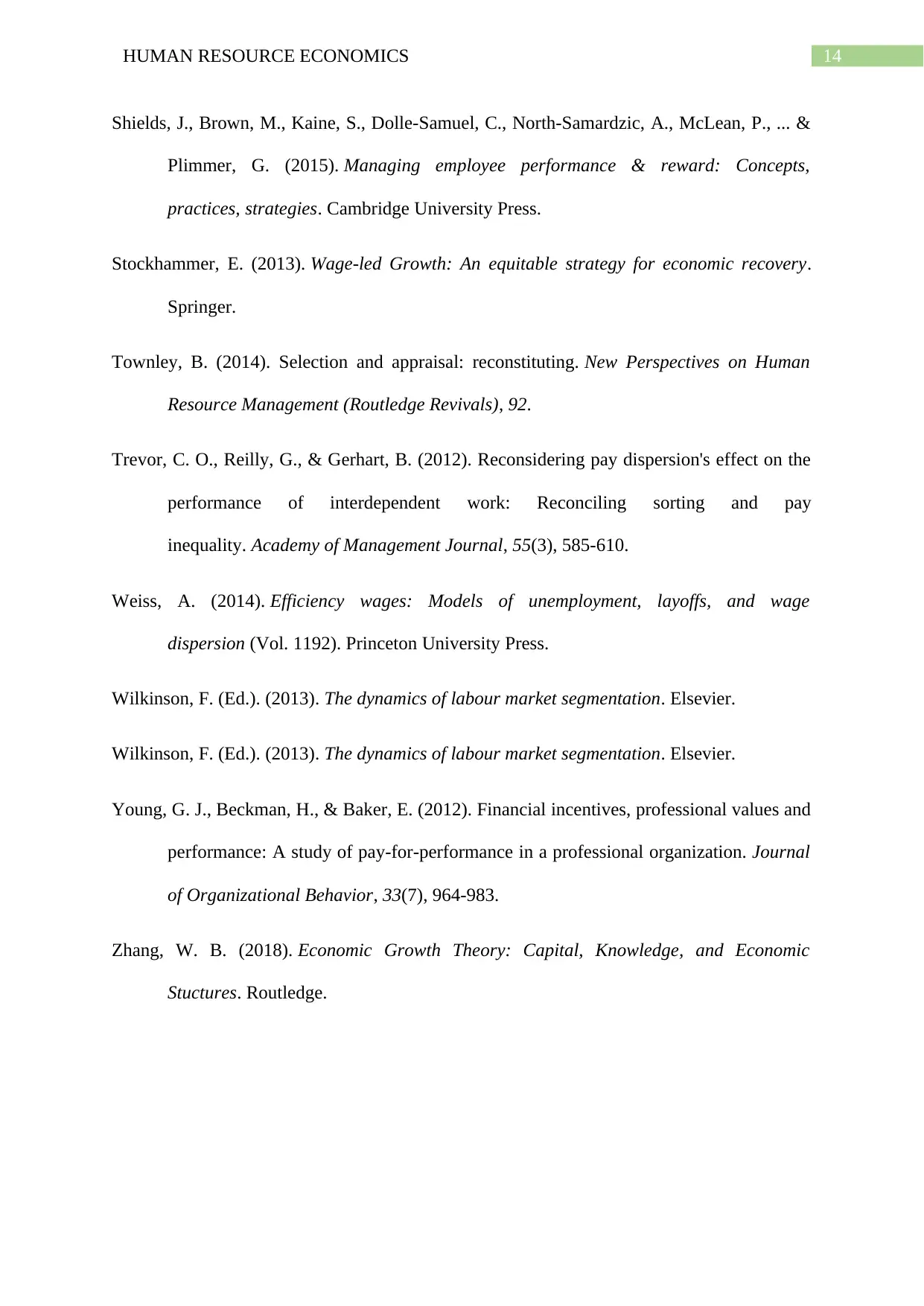
14HUMAN RESOURCE ECONOMICS
Shields, J., Brown, M., Kaine, S., Dolle-Samuel, C., North-Samardzic, A., McLean, P., ... &
Plimmer, G. (2015). Managing employee performance & reward: Concepts,
practices, strategies. Cambridge University Press.
Stockhammer, E. (2013). Wage-led Growth: An equitable strategy for economic recovery.
Springer.
Townley, B. (2014). Selection and appraisal: reconstituting. New Perspectives on Human
Resource Management (Routledge Revivals), 92.
Trevor, C. O., Reilly, G., & Gerhart, B. (2012). Reconsidering pay dispersion's effect on the
performance of interdependent work: Reconciling sorting and pay
inequality. Academy of Management Journal, 55(3), 585-610.
Weiss, A. (2014). Efficiency wages: Models of unemployment, layoffs, and wage
dispersion (Vol. 1192). Princeton University Press.
Wilkinson, F. (Ed.). (2013). The dynamics of labour market segmentation. Elsevier.
Wilkinson, F. (Ed.). (2013). The dynamics of labour market segmentation. Elsevier.
Young, G. J., Beckman, H., & Baker, E. (2012). Financial incentives, professional values and
performance: A study of pay‐for‐performance in a professional organization. Journal
of Organizational Behavior, 33(7), 964-983.
Zhang, W. B. (2018). Economic Growth Theory: Capital, Knowledge, and Economic
Stuctures. Routledge.
Shields, J., Brown, M., Kaine, S., Dolle-Samuel, C., North-Samardzic, A., McLean, P., ... &
Plimmer, G. (2015). Managing employee performance & reward: Concepts,
practices, strategies. Cambridge University Press.
Stockhammer, E. (2013). Wage-led Growth: An equitable strategy for economic recovery.
Springer.
Townley, B. (2014). Selection and appraisal: reconstituting. New Perspectives on Human
Resource Management (Routledge Revivals), 92.
Trevor, C. O., Reilly, G., & Gerhart, B. (2012). Reconsidering pay dispersion's effect on the
performance of interdependent work: Reconciling sorting and pay
inequality. Academy of Management Journal, 55(3), 585-610.
Weiss, A. (2014). Efficiency wages: Models of unemployment, layoffs, and wage
dispersion (Vol. 1192). Princeton University Press.
Wilkinson, F. (Ed.). (2013). The dynamics of labour market segmentation. Elsevier.
Wilkinson, F. (Ed.). (2013). The dynamics of labour market segmentation. Elsevier.
Young, G. J., Beckman, H., & Baker, E. (2012). Financial incentives, professional values and
performance: A study of pay‐for‐performance in a professional organization. Journal
of Organizational Behavior, 33(7), 964-983.
Zhang, W. B. (2018). Economic Growth Theory: Capital, Knowledge, and Economic
Stuctures. Routledge.
1 out of 15
Related Documents
Your All-in-One AI-Powered Toolkit for Academic Success.
+13062052269
info@desklib.com
Available 24*7 on WhatsApp / Email
![[object Object]](/_next/static/media/star-bottom.7253800d.svg)
Unlock your academic potential
© 2024 | Zucol Services PVT LTD | All rights reserved.





